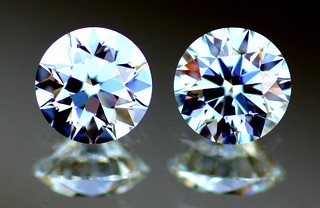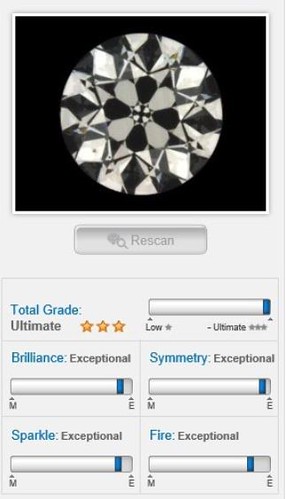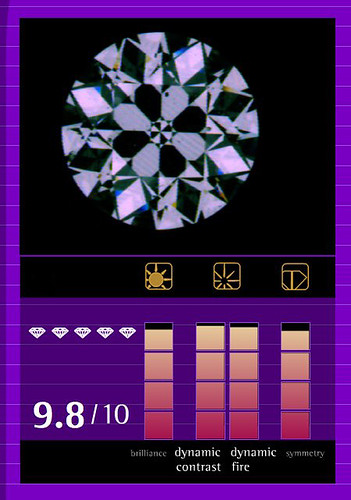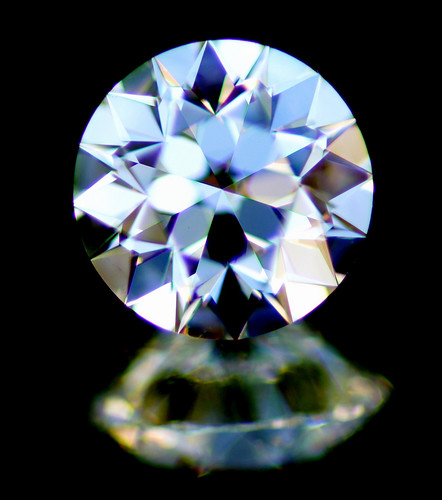The August VIntage European Cut
With the increased demand for vintage cushions, and the popularity of the August Vintage® cushion, we have seen an increased demand for another vintage diamond: the Old European Cut. However, scrutinizing buyers want an Old European Cut with repeatable, predictable, and outstanding optics.
Our response has been to create the August Vintage® European Cut.
Interestingly, the very first round brilliant cuts were Old European Cuts (“OECs”) and it was Henry Morse who, with the crude hardware of his time, cut the most beautiful Old European Cuts of his day. His work was later adopted by Tiffany and further refined by Marcel Tolkowsky as the Old European Cuts changed in appearance, primarily by altering the lower half facet length thus creating a more splintery look in rounds as opposed to the softer broader facet pattern of the Old European Cut.

Figure A: An August Vintage Round alongside a Hearts & Arrows Round
The Science Behind the Beauty of the August Vintage European Cut
The August Vintage European Cut is the first of its kind as it was developed using some of the most sophisticated optical technologies of the 21st century. When developing the August Vintage European Cut, we had 3 requirements:
1. The most beautiful optics attainable within the OEC facet structure.
2. The best spread possible when coupled with this beauty.
3. A level of precision in cutting that only the best cutters in the world could achieve.
In other words, the finest Old European Cut the world has ever seen. And we have accomplished it in the August Vintage European Cut.
The Most Beautiful Optics
Historically, the American Gemological Society has been on the forefront in leading technologies for assessing diamond optics. They have introduced the Angular Spectrum Evaluation Tool (ASET) and the Light Performance Grading Software (AGS PGS). These two technologies are the only vetted optical technologies on the market today that are based on science and empirical data. The August Vintage European Cut was developed and designed around this technology.
Figure B shows a sampling of what we would typically see when assessing various Old European Cuts under the ASET.

Figure B: Typical Old European Cuts
Understanding the Colors of the ASET
"Green” indicates light that’s entering from the horizon (0° to 45° angle). Diamonds that exhibit too much green will be labeled as “less bright.” A small amount of green in the right place is fine, but it should be limited if possible. Please note that in some fancy shapes, this can be unavoidable.
“Red” indicates direct light that is entering from a 45° to 75° angle, making the diamond appear bright from most angels of viewing.
“Blue” indicates light entering from directly above (from a 75° to 90° angle). Blue adds contrast and also gives off strong light return when viewed from different angles. To ensure that a diamond has a nice dosage of light reflection, it’s important to have some blue. We do not want an extreme amount because blues only excel from certain angles. Those angles are not as commonly viewed compared to the red angles. The color blue has also been seen as black in some of the ASET technologies.
Finally, the colors gray, white, and black indicate light leakage. You want to avoid diamonds that are heavy in those colors. Light leakage prevents the diamond from reflecting light and brilliance from those specific areas. They act as windows instead of mirrors.
The takeaway from this analysis is that we want to see a primary saturation of reds. Blue and green are ok but must be minimal and if present, properly distributed in the right places.
The perfection of the cut of the August Vintage Old European is shown in a near perfect ASET (Figure C), as well as high brilliance on the Isee2 machine which was later adopted by Sarine. Isee2 results are shown in Figure D. The August Vintage Old Eurpoean Cut outperforms even most Hearts & Arrows rounds.

Figure C: An August Vintage Old European Cut ASET


Figure D: Isee2 Brilliance Results for an August Vintage Old European Cut
The Best Possible in an Old European Cut with Ideal Optics
People who are lovers of vintage diamonds do not necessarily purchase them for how much spread the diamond has on the finger. Often, diamonds in all varieties with the "best spread" have some of the worst optics. The August Vintage European Cut, however, combines the best balance of optics and spread in an Old European Cut.
Two key features of the August Vintage Old European Cut are an aesthetic inherited from its ancient counterpart and a tall regal crown combined with a smaller table. The goal in cutting this diamond was to find a way to maintain the regal presence of the tall crown and greater depth yet provide a spread that would be comparable with today's ideal cut rounds. The August Vintage Old European Cut has succeeded in maintaining this aesthetic and in many cases, exceeding the spread of a comparably sized ideal cut round.








